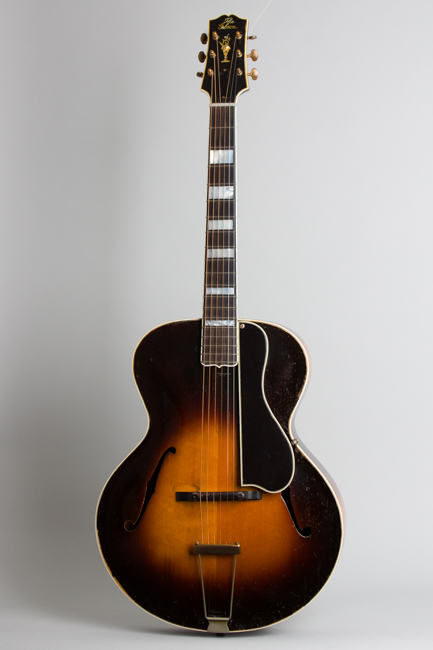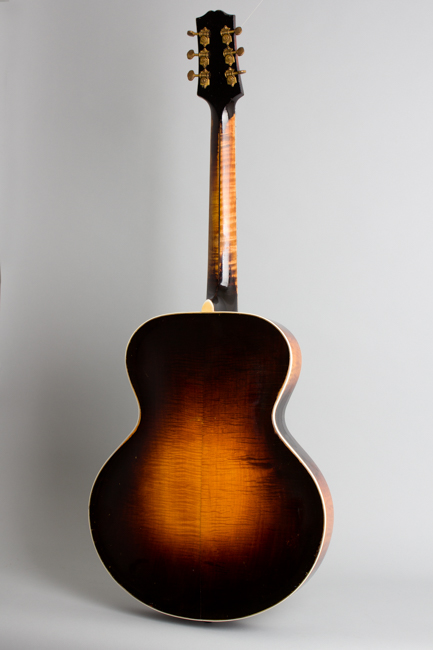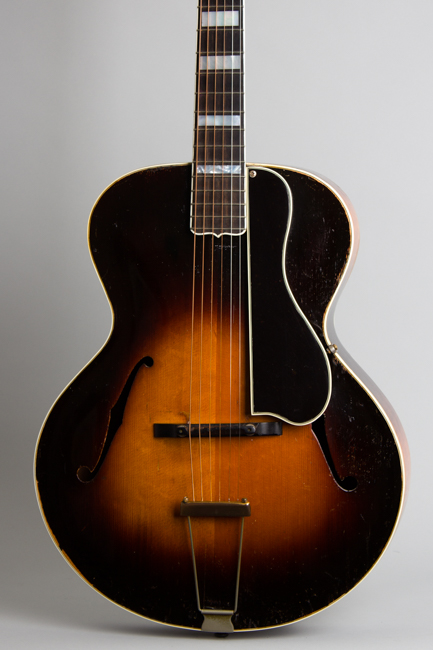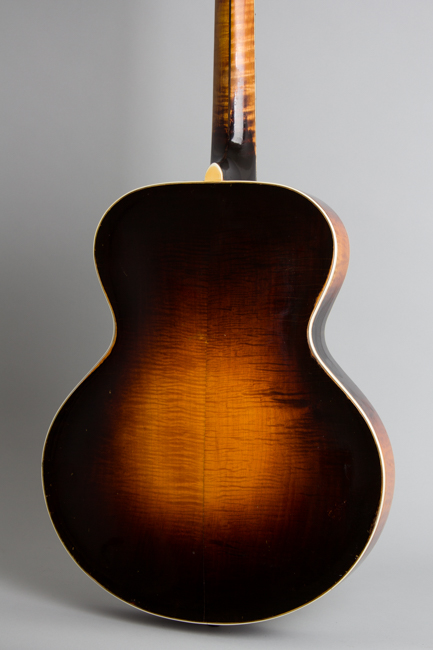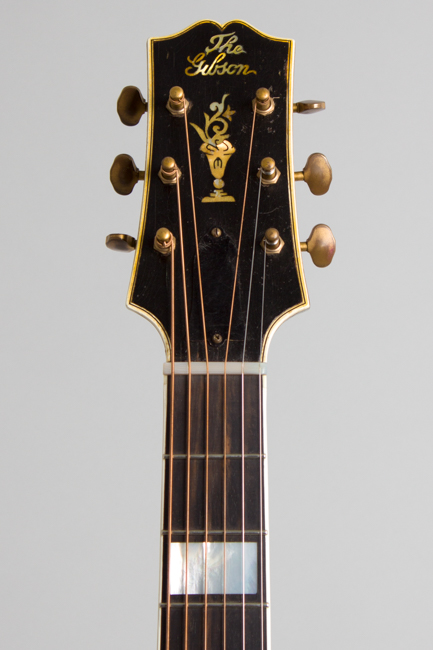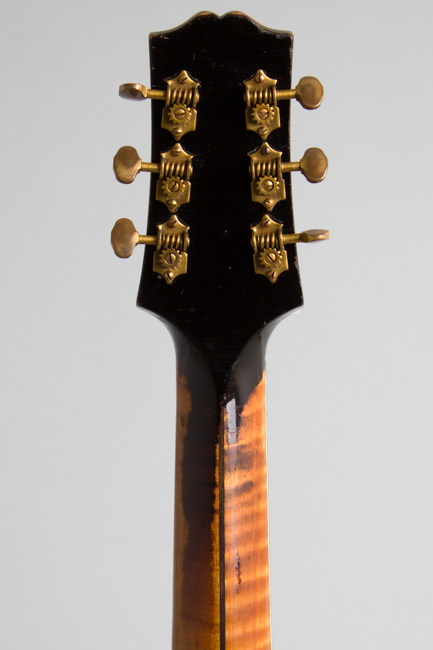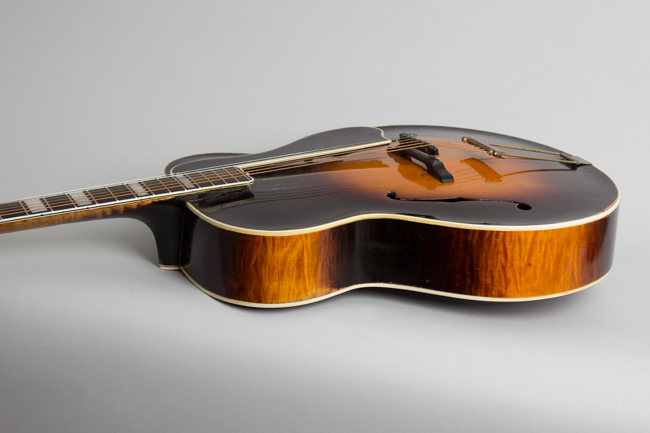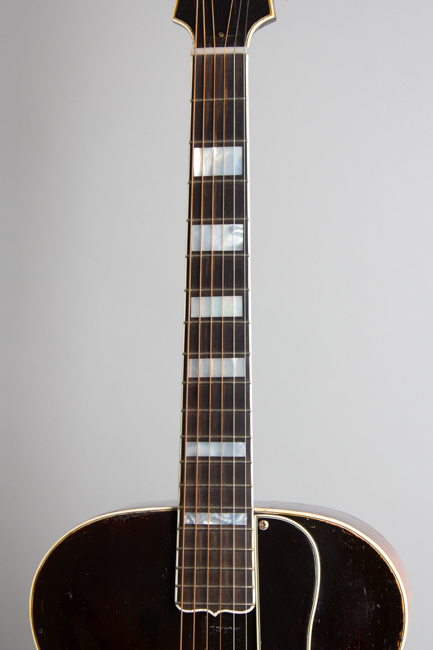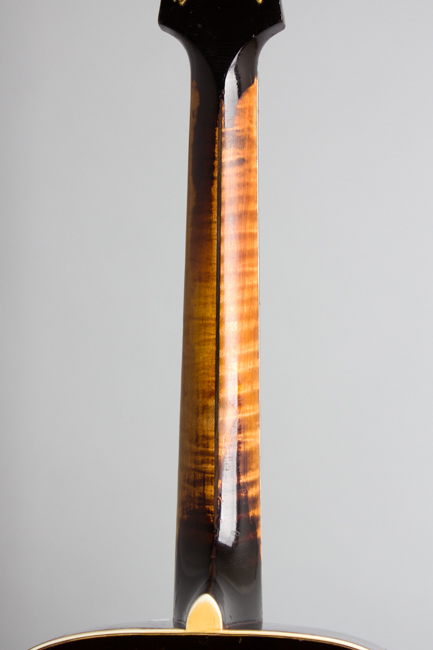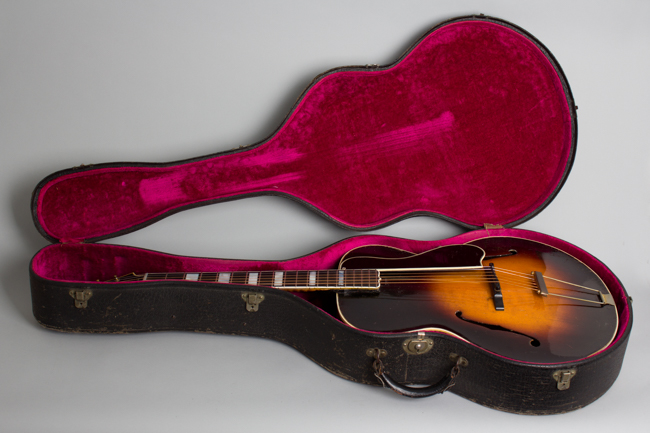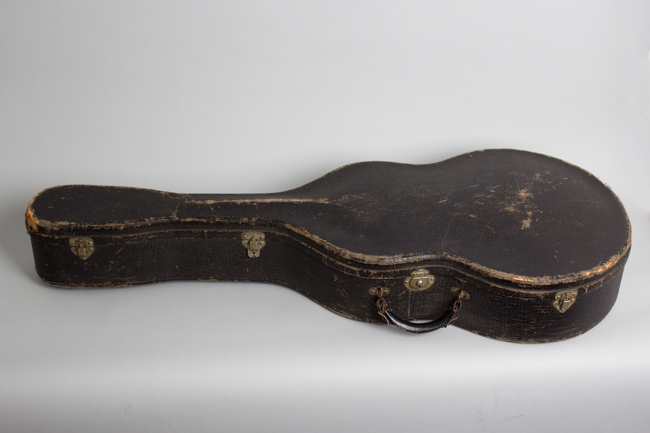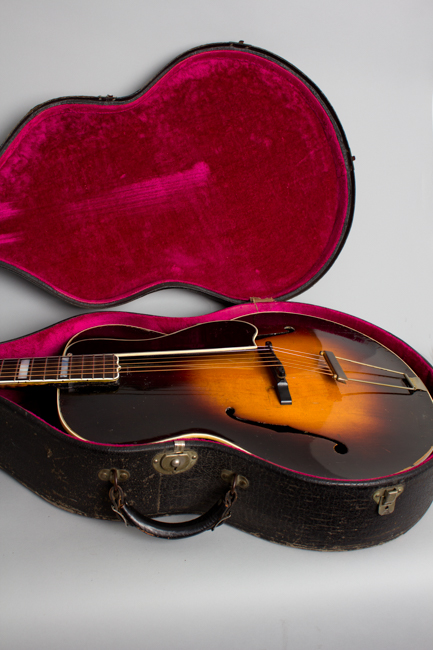Gibson L-5 Arch Top Acoustic Guitar (1934)
Summer Sale - PRICE REDUCED!
$16,000.00 + shipping
Buy NowItem # 10705
Prices subject to change without notice.
Gibson L-5 Model Arch Top Acoustic Guitar (1934), made in Kalamazoo, Michigan, serial # 1149 (FON), Cremona Brown Sunburst finish, curly maple back and sides, spruce top; maple neck with ebony fingerboard, original black hard shell case.
This 1933-4 L-5 is an interesting example of the pre-eminent orchestra guitar of its era, with one unusual if fairly subtle modification. A newer correct style pearl block inlaid fingerboard was fitted, which is not uncommon on older L-5's which were often gigged for decades. What is unusual is when this was done the scale length was increased to 25" from the original 24 3/4" design, which adds a bit of extra power to the sound. The bridge sits slightly farther back on the top as a result, and the guitar has a bit more "bark" to the tone, with a little of a more "Epi-Phonic" character to the sound than the standard L-5 of this period.
The 16" L-5 -- the original f-hole carved top guitar -- is an extremely fine instrument by any standard. Debuting in 1923-4, the L-5 was the first modern archtop, with a layout still widely copied today. At the time this one was built around ten years later it was still the top of Gibson's line and generally considered the finest guitar orchestra made.
By 1933 most dance and jazz band banjoists had converted to guitar; the L-5 along with Epiphone's Deluxe were the choice of nearly all top professional guitar players. The era's most influential guitarist, Eddie Lang, adopted a dot-neck (probably 1927) L-5, then an early block neck L-5 around 1930 setting the trend for all to follow. From that time the L-5 ruled the roost for orchestra guitars, giving Gibson a dominance they never really lost.
That said, these early 16" L-5s are fairly rare guitars today. Retailing at $275.00 (plus case), the L-5 was an extremely expensive instrument (the top-of-the-line Martin pearl-trimmed Style 0M-45 retailed at $100.00 less). At the height of the Depression, only working professional users could afford such an indulgence. Most were played extensively for years, some owners preferring them to any later guitars. They can be seen in the hands of recording studio players well into the 1960s. As constant working guitars these instruments were often modified, refitted, or refinished.
Apart from the slightly extended scale this guitar shows typical features for the early-mid 1930s; the transitions between L-5 variants inexact at best. The label is intact but the serial number has faded into oblivion. A factory order number penciled on the lower back suggests it was built in 1934.
The top, back, and sides on this guitar carry a beautifully blended dark sunburst finish; the back is tiger maple with a subtle but attractive figure. The top and back are triple bound in white celluloid. The side-line bound ebony fingerboard is done in period style with genuine pearl block inlay and the slightly pointed end used on 1920's versions. The 3-piece laminated curly maple neck is slimmer than some with a fairly prominent "V" spine and relatively shallow profile.
The pearl inlaid flowerpot in the triple-bound headstock with a straight across "Gibson" logo above are hallmarks of the 1932-35 L-5, as are the then-new Grover G-98 tuners, gold plated with metal "butterbean" buttons. The long triple-bound celluloid pickguard is screwed to the top by the neck block instead of pinned to the side of the fingerboard. The tailpiece is the 1930's "string through" style; the adjustable ebony bridge still has the 1920s split base and reversible saddle with the "Hawaiian" underside.
This instrument has a powerful and very versatile sound, typical of the early L-5s bur =t perhaps a bit of extra power from the slightly extended scale, which makes the strings a bit tauter. The tone is simultaneously warm and incisive with plenty of depth. The guitar plays perfectly and is extremely responsive for an archtop guitar...it even sounds lovely fingerstyle! While not 100% original this is now a unique example of one of our all-time favorite instruments.
Overall length is 40 3/4 in. (103.5 cm.), 16 in. (40.6 cm.) wide at lower bout, and 3 1/4 in. (8.3 cm.) in depth, measured at side of rim. Scale length is 25 in. (635 mm.). Width of nut is 1 3/4 in. (44 mm.).
Apart from the fingerboard replacement this L-5 shows remains largely original with some general wear but in excellent structural and playing condition. The finish shows some typical checking with a varied collection of scratches, dings, dents and other marks overall, a number of them touched up. The back of the neck is worn through to the wood along the spine over a decent amount of its length, and has some light overspray which appears mostly worn through again. The rim on either side of the endpin has some dark overspray which appears intended to cover a couple of areas of deeper finish wear on the rim rather than any structural repair.
As noted the guitar was at some point fitted with a new fingerboard, with the original 24 3/4" scale length extended to 25". This was quite professionally done some time ago. The fret wire is somewhat taller than the original; but not out of character. The frets have light divoting under the unwound strings in the lower positions; the ebony fingerboard itself shows very little wear. The pearl nut is a replica; by this point L-5's generally had bone nuts.
The top has a spruce grain crack just above the center seam under the tailpiece, sealed with minimal overfinish. There is one tiny crack on the upper rim, and the back center seam has been resealed, below a noticeable scrape in the upper center of the back. The "Vampire" pin marks from an old DeArmond pickup installation are touched up but still visible on the bass side of the fingerboard extension, and there is a parched strap button hole in the heel.
The hardware is original except the pickguard which is a nicely done replacement in the correct style, and what appears to be a very close replica bridge base. The original bridge saddle looks to have possibly been cut down over the adjustment wheels just slightly long ago. The neck angle is very good and there is plenty of room for action adjustment if desired. The tailpiece has lost most of the plating, especially on the crossbar.
This L-5 is still housed in the original case, which has some external wear and a replaced handle. While not 100% original this is still a great instrument to play (and to hear) and with its subtly extended scale has a unique sound and feel, even among these splendid models. Very Good + Condition.
This 1933-4 L-5 is an interesting example of the pre-eminent orchestra guitar of its era, with one unusual if fairly subtle modification. A newer correct style pearl block inlaid fingerboard was fitted, which is not uncommon on older L-5's which were often gigged for decades. What is unusual is when this was done the scale length was increased to 25" from the original 24 3/4" design, which adds a bit of extra power to the sound. The bridge sits slightly farther back on the top as a result, and the guitar has a bit more "bark" to the tone, with a little of a more "Epi-Phonic" character to the sound than the standard L-5 of this period.
The 16" L-5 -- the original f-hole carved top guitar -- is an extremely fine instrument by any standard. Debuting in 1923-4, the L-5 was the first modern archtop, with a layout still widely copied today. At the time this one was built around ten years later it was still the top of Gibson's line and generally considered the finest guitar orchestra made.
By 1933 most dance and jazz band banjoists had converted to guitar; the L-5 along with Epiphone's Deluxe were the choice of nearly all top professional guitar players. The era's most influential guitarist, Eddie Lang, adopted a dot-neck (probably 1927) L-5, then an early block neck L-5 around 1930 setting the trend for all to follow. From that time the L-5 ruled the roost for orchestra guitars, giving Gibson a dominance they never really lost.
That said, these early 16" L-5s are fairly rare guitars today. Retailing at $275.00 (plus case), the L-5 was an extremely expensive instrument (the top-of-the-line Martin pearl-trimmed Style 0M-45 retailed at $100.00 less). At the height of the Depression, only working professional users could afford such an indulgence. Most were played extensively for years, some owners preferring them to any later guitars. They can be seen in the hands of recording studio players well into the 1960s. As constant working guitars these instruments were often modified, refitted, or refinished.
Apart from the slightly extended scale this guitar shows typical features for the early-mid 1930s; the transitions between L-5 variants inexact at best. The label is intact but the serial number has faded into oblivion. A factory order number penciled on the lower back suggests it was built in 1934.
The top, back, and sides on this guitar carry a beautifully blended dark sunburst finish; the back is tiger maple with a subtle but attractive figure. The top and back are triple bound in white celluloid. The side-line bound ebony fingerboard is done in period style with genuine pearl block inlay and the slightly pointed end used on 1920's versions. The 3-piece laminated curly maple neck is slimmer than some with a fairly prominent "V" spine and relatively shallow profile.
The pearl inlaid flowerpot in the triple-bound headstock with a straight across "Gibson" logo above are hallmarks of the 1932-35 L-5, as are the then-new Grover G-98 tuners, gold plated with metal "butterbean" buttons. The long triple-bound celluloid pickguard is screwed to the top by the neck block instead of pinned to the side of the fingerboard. The tailpiece is the 1930's "string through" style; the adjustable ebony bridge still has the 1920s split base and reversible saddle with the "Hawaiian" underside.
This instrument has a powerful and very versatile sound, typical of the early L-5s bur =t perhaps a bit of extra power from the slightly extended scale, which makes the strings a bit tauter. The tone is simultaneously warm and incisive with plenty of depth. The guitar plays perfectly and is extremely responsive for an archtop guitar...it even sounds lovely fingerstyle! While not 100% original this is now a unique example of one of our all-time favorite instruments.
Overall length is 40 3/4 in. (103.5 cm.), 16 in. (40.6 cm.) wide at lower bout, and 3 1/4 in. (8.3 cm.) in depth, measured at side of rim. Scale length is 25 in. (635 mm.). Width of nut is 1 3/4 in. (44 mm.).
Apart from the fingerboard replacement this L-5 shows remains largely original with some general wear but in excellent structural and playing condition. The finish shows some typical checking with a varied collection of scratches, dings, dents and other marks overall, a number of them touched up. The back of the neck is worn through to the wood along the spine over a decent amount of its length, and has some light overspray which appears mostly worn through again. The rim on either side of the endpin has some dark overspray which appears intended to cover a couple of areas of deeper finish wear on the rim rather than any structural repair.
As noted the guitar was at some point fitted with a new fingerboard, with the original 24 3/4" scale length extended to 25". This was quite professionally done some time ago. The fret wire is somewhat taller than the original; but not out of character. The frets have light divoting under the unwound strings in the lower positions; the ebony fingerboard itself shows very little wear. The pearl nut is a replica; by this point L-5's generally had bone nuts.
The top has a spruce grain crack just above the center seam under the tailpiece, sealed with minimal overfinish. There is one tiny crack on the upper rim, and the back center seam has been resealed, below a noticeable scrape in the upper center of the back. The "Vampire" pin marks from an old DeArmond pickup installation are touched up but still visible on the bass side of the fingerboard extension, and there is a parched strap button hole in the heel.
The hardware is original except the pickguard which is a nicely done replacement in the correct style, and what appears to be a very close replica bridge base. The original bridge saddle looks to have possibly been cut down over the adjustment wheels just slightly long ago. The neck angle is very good and there is plenty of room for action adjustment if desired. The tailpiece has lost most of the plating, especially on the crossbar.
This L-5 is still housed in the original case, which has some external wear and a replaced handle. While not 100% original this is still a great instrument to play (and to hear) and with its subtly extended scale has a unique sound and feel, even among these splendid models. Very Good + Condition.
